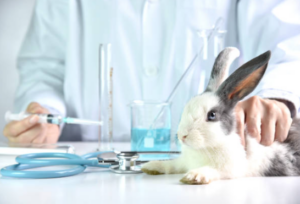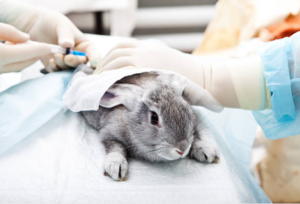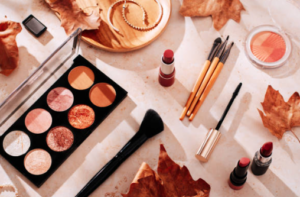A Model for Global Cosmetic Regulation

In recent years, the beauty industry has witnessed a monumental shift towards ethical practices and cruelty-free standards. One of the pivotal moments in this movement was the European Union’s ban on animal testing for cosmetics, commonly referred to as the “EU Ban on Bunny Testing.” This groundbreaking regulation has not only transformed the landscape of the European cosmetics market but also set a powerful example for the global beauty industry to follow.
The History of Animal Testing in Cosmetics
The use of animals in cosmetics testing traces its roots back to the early 20th century when the beauty industry sought methods to ensure the safety and efficacy of its products. Initially, the testing involved applying cosmetic formulations directly to the skin and eyes of rabbits to observe potential adverse reactions. Unfortunately, this practice persisted and evolved over the years into a standard industry procedure.
Rabbits, due to their relatively docile nature and large eyes, became the primary subjects for these tests. One notorious test involved the Draize eye test, where substances were applied to the eyes of restrained rabbits, leading to painful reactions and, in some cases, blindness. Similarly, skin irritation tests were conducted by applying substances to the shaved skin of animals, causing discomfort and potential harm.
As the cosmetic industry expanded, so did the demand for safety testing. Animals such as guinea pigs, mice, and rats were also subjected to various tests, contributing to a systemic culture of animal experimentation within the beauty sector. The rationale behind these practices was rooted in the belief that testing on animals was a necessary sacrifice for human safety and well-being.
The 1980s and 1990s saw a surge in public awareness and activism against animal testing in cosmetics. High-profile campaigns exposed the grim reality of testing procedures, fostering a global movement that called for the adoption of cruelty-free alternatives. Celebrities and animal rights organizations played a pivotal role in shedding light on the inhumane practices, prompting consumers to reconsider their support for brands involved in animal testing.

The EU Ban: A Game-Changer in Beauty Legislation
The European Union’s ban on animal testing for cosmetics, implemented in 2013, marked a revolutionary shift in the beauty industry’s approach to product safety. Unlike previous regulations that merely restricted the testing of finished cosmetic products, the EU Ban extended its reach to encompass individual ingredients, sending a resounding message that cruelty-free practices were not just encouraged but mandated.
- Comprehensive Scope: The EU Ban went beyond a mere symbolic gesture. It enforced a comprehensive prohibition on the sale of cosmetics and cosmetic ingredients that had been tested on animals anywhere in the world. This ambitious move signified a commitment to eradicating the global demand for animal-tested products and spurred a reevaluation of ingredient sourcing and testing methodologies by cosmetic companies worldwide.
- Phase-out Approach: Recognizing the need for a transition period, the EU Ban implemented a phased approach. From the initial ban on testing finished cosmetic products in 2004, the legislation progressed to include a ban on animal testing for individual cosmetic ingredients in 2009. This phased implementation allowed the industry to adapt gradually, encouraging innovation in cruelty-free testing methods.
- Incentivizing Alternatives: A key element of the EU Ban’s success lies in its proactive approach to incentivizing the development and adoption of alternative testing methods. By promoting research into innovative technologies, the legislation encouraged the cosmetic industry to explore and invest in cruelty-free testing solutions. This focus on alternatives not only upheld ethical standards but also stimulated advancements in scientific research.
- Global Impact: Perhaps one of the most profound aspects of the EU Ban is its global influence. The legislation served as a model for other regions, inspiring them to reevaluate their stance on animal testing. Countries and jurisdictions outside the EU began considering similar measures, acknowledging the ethical imperative of cruelty-free beauty practices.
- Consumer Empowerment: The EU Ban empowered consumers by providing them with a clear standard for cruelty-free products. The “leaping bunny” logo, indicating a product is certified cruelty-free, became a recognizable symbol for conscientious shoppers. This transparency not only influenced purchasing decisions but also fostered a sense of responsibility among consumers to support brands committed to ethical practices.
- Industry Transformation: In response to the EU Ban, the beauty industry underwent a transformative process. Companies faced with the choice of adapting to cruelty-free standards or losing access to the lucrative European market opted for the former. This shift catalyzed a wave of innovation, with brands investing in research and development to create products that met both ethical and regulatory standards.
- Economic Viability: Contrary to initial concerns about economic ramifications, the EU Ban demonstrated that cruelty-free practices are not only ethically sound but also economically viable. The growing demand for cruelty-free products among consumers translated into increased market share for brands that embraced ethical standards. This economic incentive further solidified the notion that compassion and profitability can coexist in the beauty industry.
- Advancing Scientific Knowledge: The EU Ban prompted a reevaluation of the scientific community’s understanding of safety testing. The focus on alternative methods fostered collaboration between scientists, researchers, and industry professionals to develop cutting-edge technologies that could replace outdated animal testing practices. This commitment to advancing scientific knowledge contributed to a more progressive and humane approach to cosmetic safety.
Critics often argue that banning animal testing may compromise the safety and efficacy of cosmetic products. However, advancements in technology have paved the way for innovative and cruelty-free testing methods. From in vitro testing to sophisticated computer models, the beauty industry now has a myriad of alternatives that not only spare animals from suffering but also provide reliable data for product safety assessments.
Contrary to concerns about economic repercussions, the EU Ban on Bunny Testing has had a positive impact on the cosmetics market in Europe. Consumers increasingly favor cruelty-free products, leading to a surge in demand for brands that align with ethical standards. This shift in consumer behavior has encouraged companies to prioritize cruelty-free practices, fostering a competitive market that values both ethics and innovation.

Encouraging Other Regions to Follow Suit
The success of the EU Ban has not gone unnoticed by other regions around the world. Several countries and jurisdictions have started considering similar legislation to ban or restrict animal testing in cosmetics. This global momentum is a testament to the EU’s influence and the growing acknowledgment that cruelty-free beauty is not just a trend but a necessity for a progressive and conscientious industry.
While the EU Ban on Bunny Testing has been widely celebrated, it is not without its challenges and controversies. Some argue that certain regions lack the infrastructure or resources to adopt similar measures effectively. Additionally, there are ongoing debates about the definition of cruelty-free, especially in a globalized industry where ingredients and products cross international borders.
Consumer activism has played a pivotal role in shaping the trajectory of the beauty industry, particularly in the context of the EU Ban on animal testing. The surge in awareness and demand for cruelty-free products can be attributed to the collective voice of conscious consumers who have used various platforms to express their concerns, hold brands accountable, and drive positive change.
- Social Media Amplification: The advent of social media platforms has significantly amplified the impact of consumer activism. Platforms like Instagram, Twitter, and Facebook have become powerful tools for consumers to share information, experiences, and campaigns dedicated to ending animal testing. Hashtags such as #CrueltyFree and #EndAnimalTesting have trended globally, creating virtual communities of like-minded individuals committed to ethical beauty practices.
- Petitions and Campaigns: Online petition platforms and dedicated campaigns have empowered consumers to take collective action. Petitions urging brands to adopt cruelty-free practices or calling for legislative changes have garnered millions of signatures. Notable organizations like Cruelty Free International and PETA (People for the Ethical Treatment of Animals) have spearheaded impactful campaigns, leveraging consumer support to pressure brands into abandoning animal testing.
- Celebrity Endorsement: Celebrities and influencers have played a crucial role in leveraging their influence to champion cruelty-free beauty. Many high-profile figures within the entertainment and beauty industries have publicly endorsed and supported campaigns against animal testing. Their participation not only brings visibility to the cause but also encourages their followers to make informed and ethical choices in their beauty purchases.
- Boycotts and Buycotts: Conscious consumers have demonstrated their commitment to cruelty-free beauty by engaging in both boycotts and buycotts. While some choose to boycott brands that continue to test on animals, others actively support and promote brands that have adopted cruelty-free practices. This dual approach sends a clear message to the industry that ethical considerations influence purchasing decisions.
- Educational Initiatives: Consumer activism is not solely about protest; it is also about education. Activists and organizations dedicated to cruelty-free beauty have undertaken educational initiatives to inform consumers about the impact of animal testing and the availability of cruelty-free alternatives. Educational content, ranging from informative articles to engaging videos, empowers consumers to make informed choices and encourages a broader understanding of ethical beauty practices.
- Direct Engagement with Brands: Social media platforms have provided consumers with direct lines of communication to brands. This direct engagement allows consumers to inquire about a brand’s stance on animal testing, seek transparency regarding their supply chain, and express their expectations for cruelty-free products. Brands responsive to consumer inquiries often build trust and loyalty within the conscious consumer community.
- Legislative Advocacy: Beyond influencing individual brand practices, consumer activism has been instrumental in advocating for legislative changes. Petitions, letter-writing campaigns, and public demonstrations have pressured governments to consider and implement cruelty-free regulations. Consumers actively participating in these efforts have demonstrated that they not only demand change at the individual brand level but also support broader systemic transformations.
- Shifting Market Dynamics: The collective impact of consumer activism has contributed to a significant shift in market dynamics. The increased demand for cruelty-free products has forced brands to reassess their practices and prioritize ethical considerations. This shift, in turn, has created a more competitive landscape where brands vie not only for product innovation but also for alignment with consumer values.

As we look ahead, the EU Ban on Bunny Testing serves as a beacon of hope for the future of cruelty-free beauty. The beauty industry is at a crossroads, with an increasing number of brands recognizing the need to prioritize ethics alongside innovation. The global momentum towards cruelty-free practices indicates a promising future where beauty is synonymous with compassion, responsibility, and conscious consumer choices.
The EU Ban on Bunny Testing stands as a remarkable milestone in the beauty industry’s journey towards cruelty-free practices. As consumers, brands, and policymakers unite in their commitment to ethical beauty, the impact of this regulation reverberates globally. The EU’s model serves as an inspiration for regions worldwide to adopt similar measures, ushering in an era where beauty is defined not only by aesthetics but also by compassion and responsibility.

